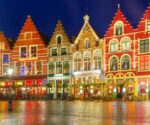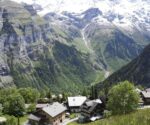Lesser-known ‘eighth continent’ has crystal water and stunning beaches | Africa | Travel
A massive island that has been geologically isolated from the rest of the globe for millions of years is frequently dubbed the “eighth continent”.
Whilst numerous nations boast a handful of unique animal species, Madagascar truly sets itself apart. Researchers believe that approximately 90% of its flora and fauna cannot be found anywhere else on the planet. Madagascar hosts nearly 100 lemur species, some of the planet’s most spectacular chameleons, over a hundred bird species that are exclusively native to the island, and seven distinct varieties of baobab tree.
These natural marvels are nestled amongst tropical rainforests, thorny deserts, and extensive, pristine coastlines. Such is the extraordinary diversity of the island’s wildlife and plant life, certain ecologists contend it deserves recognition as a continent rather than merely a nation.
Madagascar’s distinctive form and extent mean it boasts one of the world’s most extensive shorelines. Its 3,000-mile coastline represents Africa’s longest, providing an abundance of spectacular beaches. Among the countless options available, Île Sainte-Marie receives high praise for whale watching opportunities, whilst Andilana Beach on Nosy Be is widely regarded as breathtaking. The isolated and picturesque shores near Morondava, alongside the coastal and thorny woodland landscapes of Ifaty, prove particularly striking.
Madagascar’s vast size and geographic diversity mean climate conditions vary dramatically across different regions. The warmest periods typically occur during December and January, when coastal temperatures average in the high 20s – ideal conditions for taking a dip. Plunging into the crystal-clear waters, one can’t help but be reminded of Madagascar’s ancient history.
Once a part of the supercontinent Gondwana, it broke away and separated from India approximately 88 million years ago. Since then, its flora and fauna have evolved in isolation, with very few new species arriving and almost none leaving. This prolonged separation is the reason why so many species are endemic to Madagascar, found nowhere else on Earth.
The island’s unique geography contributes to this biodiversity. A central highland range divides the humid eastern rainforests from the drier western and southern regions. The west boasts magnificent limestone “tsingy” formations and arid plains, while the east is home to cloud forests and rivers. Species have adapted to these specific parts of the landscape.
While many now face threats from deforestation and climate change, most visitors are simply captivated by how different everything appears, sounds, and behaves compared to mainland Africa. Travel experts at Sundowner Holidays, who organise bespoke trips across the island, describe Madagascar as a haven for nature enthusiasts.
Lemurs – the island’s most iconic creatures – are naturally found only here, with over 100 recognised species and subspecies. They vary from tiny palm-sized mouse lemurs to the indri, which can grow nearly a metre tall. Different lemurs inhabit different habitats: ring-tailed lemurs wander the dry south, while indris reside in the eastern.
Rainforests witness “dancing” sifakas bounding through gallery forests and rocky gorges, whilst the nocturnal aye-aye inhabits coastal and inland woodlands. All lemurs descended from ancient primates that somehow arrived on the island—likely by drifting across the ocean on vegetation rafts.
Across millions of years, they flourished without rivalry from monkeys or apes. Their vocalisations now characterise many regions of Madagascar. The indri’s extended, ascending call carries for kilometres at daybreak, whilst sifakas yelp and growl as they bound between tree trunks.
The reptiles are equally remarkable. Roughly two-thirds of the globe’s chameleon species inhabit Madagascar, from the enormous Parson’s chameleon to minuscule leaf chameleons compact enough to perch on a fingernail. They possess the characteristic rotating eyes, gripping feet, and colour-shifting skin and can be discovered in numerous national parks, from rainforests to arid woodlands.
Guides frequently highlight several species during a single evening trek. Then there’s the fossa—a streamlined, feline-like carnivore more closely linked to mongooses. It serves as Madagascar’s apex terrestrial predator and exists solely on this island.
Other distinctive creatures include tenrecs (spiky insect-consumers resembling hedgehogs), vibrant day geckos, and a remarkable diversity of frogs, nearly all endemic to Madagascar. Madagascar’s flora proves just as peculiar as its fauna.
Of the nine recognised baobab tree species worldwide, six exist exclusively here. Some have survived for considerably more than a millennium. Their enlarged trunks and Slender crowns create an almost mystical atmosphere across parts of the western coastline, particularly along the renowned Avenue of the Baobabs near Morondava, where towering trees border a dusty track frequented by local farmers and zebu carts.
Botanist Nisa Karimi explains it succinctly: “One species occurs all across continental Africa, and then you get to Madagascar, and you have six.” Sundowner Holidays recommends that the optimal approach to witness this remarkable diversity of flora and fauna involves exploring multiple distinct regions during a single journey, rather than remaining at just one resort.
For countless visitors, the enduring impression isn’t merely a single creature or plant but the sensation that virtually everything they encounter—from a lemur in the treetops to a miniature chameleon on a twig or a line of baobabs at dusk—belongs to a realm that exists exclusively on this solitary island.
Booking through a package operator or tour operator is the preferred method for most visitors to Madagascar. Reaching the destination proves challenging, as no direct flights operate from the UK, requiring at least one connection. Routes commonly link through hubs such as Paris (CDG) and Johannesburg, with favoured carriers for this journey including Kenya Airways, Ethiopian Air, and Air France. The majority arrive at the primary airport, Ivato International Airport (TNR) in Antananarivo.









